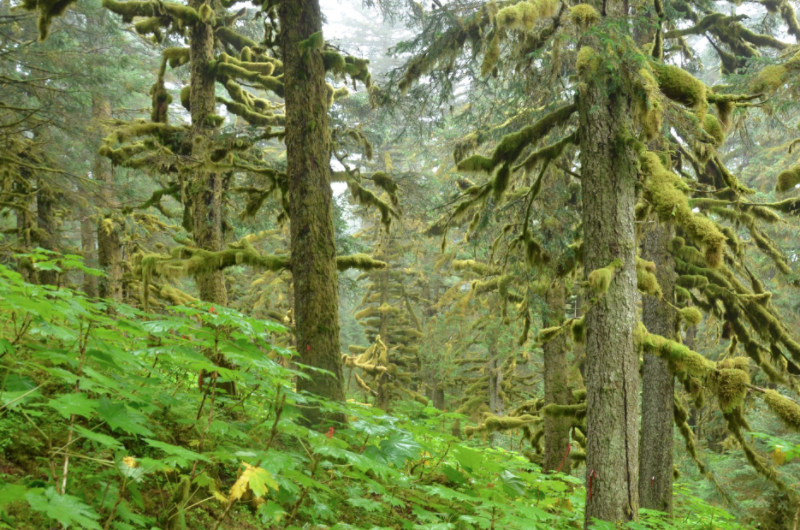Alaska
The Afognak project secured and is protecting 8,200+ acres of coastal temperate rain forest on Afognak Island in Alaska, under a conservation easement in order to capture and store up to 1.18 million metric tonnes of CO2. Protecting old growth forests and allowing areas previously logged for timber to regenerate is helping biodiversity thrive including Kodiak brown bear, river otter, bald eagle and five different species of Pacific salmon. Learn more
Carbon Standard: Verra UN SDGs: 13, 15
Costa Rica
The Los Santos wind project helped fund the installation, and is funding the ongoing operation of a 12.75 Megawatt wind farm–supplying renewable energy to an estimated 50,000 rural community members who previously lacked access to reliable electricity. It reduces more than 15,000 metric tonnes of CO2 from entering the atmosphere each year–by removing the dependence on cutting down trees for cooking fuel and burning gasoline and diesel for energy, sustains 20 local jobs and improves community safety. Learn more
Carbon Standard: Gold Standard UN SDGs: 3, 7, 8, 12, 13, 17
Chile
The Viñales project is eliminating the use of coal for energy production, and instead using what historically was waste from operations (sawdust). This biomass renewable energy project keeps an estimated 258,000 metric tonnes of CO2 from entering the atmosphere each year, while providing reliable energy and better air quality to local communities. Learn more
Carbon Standard: Verra | UN SDGs: 7, 11, 12, 13
South Dakota
The Crow Lake wind project is lowering the carbon intensity of electricity production in one of the United States’ top 10 energy consuming states per capita–it reduces more than 431,000 metric tonnes of CO2 per year. Its unique stakeholder structure includes ownership by local community members, a not-for-profit, wholesale electric generation and transmission cooperative and Mitchell Technical Institute-creating an opportunity for real world training and employment opportunities. Crow Lake produces 162 MW of renewable power–enough to supply as many as 129,000 homes.
Carbon Standard: Verra UN SDGs: 7, 8, 11, 13
MaLAWI
Distributing and installing 500,000 fuel-efficient, improved cookstoves throughout Malawi is helping to halt rapidly progressing deforestation, reducing health hazards from indoor smoke pollution, and providing women and children more time away from collecting firewood–with a climate impact of 19+ million metric tonnes CO2 reduced from entering our atmosphere.
Carbon Standard: Verra UN SDGs: 1, 2, 3, 4, 5, 7, 8, 9, 13, 15
COLORADO
Southern Plains Land Trust (SPLT) is an accredited land trust that works to preserve the shortgrass prairie ecosystems of the southern Great Plains in Colorado–with a focus on creating a network of prairie preserves that provide refuge for native wildlife including the swift fox, ferruginous hawk, burrowing owl, and mountain plover. Carbon finance (carbon offsets) help fund the purchase and conservation of these grasslands and keep them from being converted for agricultural or commercial development purposes. The current network of SPLT prairie preserves is protecting 25,000 acres and reducing/removing more than 12,600 metric tonnes of CO2 per year. Learn more
Carbon Standard: Climate Action Reserve UN SDGs: 13, 15
FLORIDA
Using proprietary technology to enhance voluntary control of N2O (nitrous oxide) emissions, a greenhouse gas (GHG) that is a by-product of manufacturing various products like military and first responder uniforms, and passenger vehicle components including airbags. N2O has a global warming potential 265 times higher than carbon dioxide, which is why the Ascend Performance Phlogiston project destroys N2O at the source, preventing it from ever entering the atmosphere.
Carbon Standard: Climate Action Reserve UN SDGs: 12, 13
GUATEMALA
The San Antonio El Sitio project is lowering the carbon intensity of electricity on Guatemala’s National Interconnected System grid by more than 81,000 metric tonnes of CO2 per year. Situated in the Los Llanos village of the municipality of Villa Canales, it produces 55.2 MW of renewable power–enough to supply as many as 20,000 homes in a region historically dependent on fossil fuels.
Carbon Standard: UN CDM UN SDGs: 7, 8, 11, 13
Colombia
The Selva de Matavén project protects more than 1.5 million hectares of natural forests in the Indigenous Reservation of the Matavén Forest in Colombia - helping to avoid an average 3.6+ million metric tonnes of CO2 from being released into the atmosphere each year, while safeguarding biodiversity and providing improved education, healthcare, sanitation, and food security for 16,000 indigenous community members.
Carbon Standard: Verra UN SDGs: 1, 2, 3, 4, 5, 13, 14, 15
uruguay
The Guarané forest restoration project is restoring degraded grasslands to improve soil quality and biodiversity, while increasing carbon sequestration and quality employment opportunities throughout Uruguay’s rural communities.
Carbon Standard: Verra UN SDGs: 8, 13, 15
BRAZIL
Salto Pilão is a run-of-river hydroelectric plant lowering the carbon intensity of electricity production in southern Brazil, and helping to increase the share of renewables as energy demand rises due to economic growth in the region. It reduces more than 290,000 metric tonnes of CO2 per year and creates local jobs.
Carbon Standard: Verra UN SDGs: 7, 8, 9, 13
*Listed projects are either currently, or have previously been supported by and through Offset Alliance subscribers, partner offset programs and our Offset Climate Certified® program. This list is updated on a semi-annual basis and may not reflect our entire portfolio of verified carbon offset projects.












